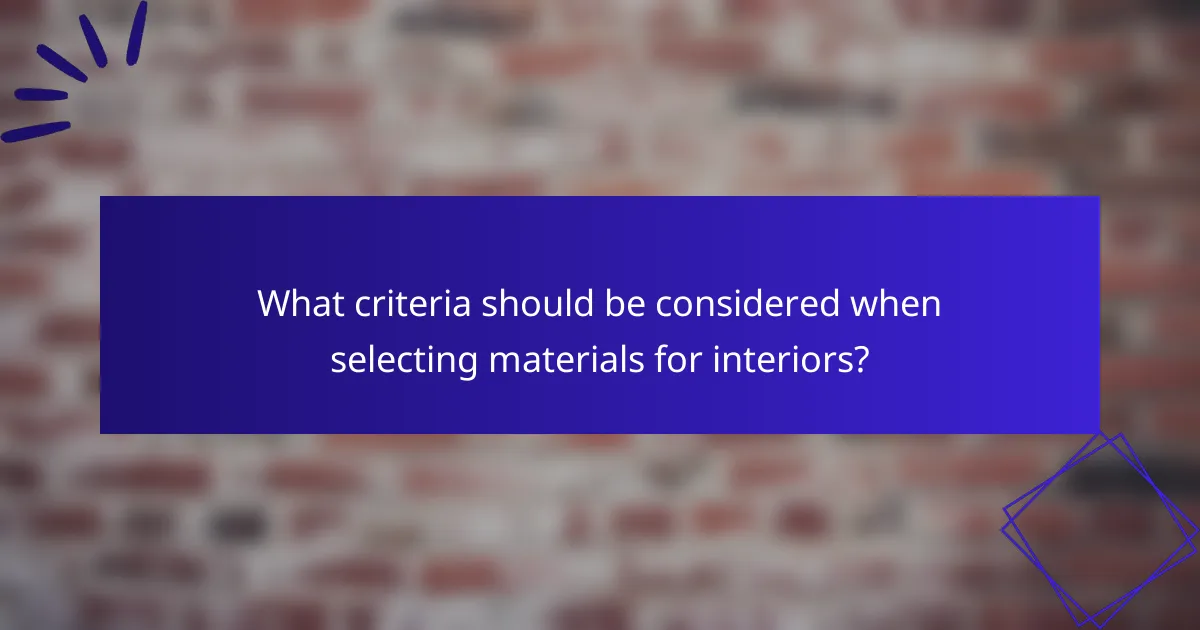Amazing materials are essential for achieving aesthetic versatility in interior design, allowing for the creation of unique and appealing spaces. Natural wood, marble, textured fabrics, glass, and metal finishes can be expertly combined to reflect diverse styles and preferences, while also addressing functionality and sustainability. The choice of materials not only influences the visual appeal but also embodies cultural values and the overall atmosphere of a space.

What are the best materials for aesthetic versatility in interior design?
The best materials for aesthetic versatility in interior design include natural wood, marble, textured fabrics, glass, and metal finishes. These materials can be combined in various ways to create unique and appealing spaces that cater to different styles and preferences.
Natural wood
Natural wood is a timeless choice that adds warmth and character to any interior. It can be used in flooring, furniture, and decorative elements, allowing for a range of styles from rustic to modern.
When selecting wood, consider the grain patterns and finishes. Lighter woods like maple or birch can create a fresh, airy feel, while darker woods like walnut or mahogany offer a more sophisticated ambiance.
Marble
Marble is synonymous with luxury and elegance, making it a popular choice for countertops, flooring, and accent walls. Its unique veining patterns ensure that each piece is one-of-a-kind.
While marble can be quite expensive, its durability and timeless appeal often justify the investment. It’s essential to seal marble surfaces to prevent staining and maintain their beauty over time.
Textured fabrics
Textured fabrics, such as velvet, linen, and wool, add depth and interest to interiors. They can be used in upholstery, curtains, and cushions to create a cozy atmosphere.
When choosing fabrics, consider their durability and ease of maintenance. For high-traffic areas, opt for more resilient materials that can withstand wear while still looking stylish.
Glass
Glass is a versatile material that can enhance the sense of space and light in a room. It is commonly used in windows, doors, and decorative elements like mirrors and glass tables.
Incorporating glass can create a modern aesthetic, but be mindful of safety and privacy. Frosted or tinted glass can provide a stylish solution while maintaining a sense of openness.
Metal finishes
Metal finishes, including brass, stainless steel, and copper, can add a contemporary edge to interior design. They are often used in fixtures, hardware, and decorative accents.
Mixing different metal finishes can create visual interest, but aim for a cohesive look by sticking to a limited color palette. Regular maintenance is necessary to prevent tarnishing and keep the finishes looking their best.

How do materials influence interior design trends in major cities?
Materials play a crucial role in shaping interior design trends across major cities, affecting aesthetics, functionality, and sustainability. The choice of materials can reflect cultural values, environmental considerations, and the overall vibe of a city.
Urban minimalism in New York
In New York, urban minimalism emphasizes simplicity and functionality, often utilizing materials like concrete, glass, and metal. This trend promotes open spaces and clean lines, creating a sense of calm amidst the city’s hustle and bustle.
Key elements include neutral color palettes and multifunctional furniture, allowing for efficient use of limited space. Designers often incorporate natural light through large windows and reflective surfaces to enhance the minimalist aesthetic.
Rustic charm in Nashville
Nashville’s interior design trend leans towards rustic charm, characterized by the use of reclaimed wood, stone, and vintage furnishings. This approach creates warm, inviting spaces that reflect the city’s rich musical heritage and Southern hospitality.
Common features include exposed beams, distressed finishes, and handmade decor. Integrating local artisanal crafts can further enhance the authenticity and charm of Nashville’s interiors.
Modern luxury in Los Angeles
Los Angeles showcases a modern luxury style that combines sleek lines with high-end materials such as marble, brass, and custom textiles. This trend emphasizes comfort and sophistication, often featuring open layouts that blur the lines between indoor and outdoor living.
Designers focus on creating luxurious yet functional spaces, incorporating smart home technology and eco-friendly materials. Large windows and outdoor terraces are common, allowing for abundant natural light and stunning views of the California landscape.

What applications of materials enhance aesthetic appeal?
Materials play a crucial role in enhancing aesthetic appeal across various applications in interior design. By selecting the right materials, designers can create visually striking environments that reflect personal style and functionality.
Wall coverings
Wall coverings significantly influence the overall aesthetic of a space. Options like wallpaper, wood paneling, and textured finishes can add depth and character to interiors. For instance, using bold patterns can create a focal point, while neutral tones may provide a calming backdrop.
When choosing wall coverings, consider the room’s purpose and lighting. In high-traffic areas, durable materials like vinyl or washable wallpaper are practical choices, while softer materials like fabric can enhance comfort in bedrooms or living rooms.
Furniture design
Furniture design is essential for both functionality and aesthetics in interior spaces. Materials such as wood, metal, and upholstery can dramatically alter the look and feel of a room. For example, sleek metal furniture can lend a modern touch, while rustic wood pieces may evoke warmth and coziness.
When selecting furniture, consider the scale and proportion relative to the space. Mixing materials can create visual interest, but aim for a cohesive color palette to maintain harmony. Avoid overcrowding a room with too many pieces; instead, focus on key items that enhance the overall design.
Lighting fixtures
Lighting fixtures are vital for creating ambiance and highlighting design elements. Materials like glass, metal, and fabric can influence the quality of light and the mood of a room. For instance, a crystal chandelier can add elegance, while industrial-style fixtures may contribute to a more contemporary vibe.
When choosing lighting, consider both function and style. Layering different types of lighting—ambient, task, and accent—can enhance the aesthetic appeal and practicality of a space. Be mindful of energy efficiency; opting for LED fixtures can reduce energy costs while providing excellent illumination.

What criteria should be considered when selecting materials for interiors?
When selecting materials for interiors, consider durability, maintenance, and cost-effectiveness. These factors significantly influence the longevity, upkeep, and overall budget of your interior design project.
Durability
Durability refers to how well a material withstands wear, pressure, and environmental factors over time. For instance, hardwood flooring is often more durable than laminate, making it a better choice for high-traffic areas.
Evaluate the expected lifespan of materials based on their intended use. For example, natural stone surfaces can last decades with proper care, while softer materials like certain woods may require more frequent replacement.
Maintenance
Maintenance involves the effort required to keep materials looking their best. Some materials, like quartz countertops, are relatively low-maintenance, requiring only regular cleaning, while others, such as natural wood, may need periodic sealing or refinishing.
Consider the time and resources you can dedicate to upkeep. Choosing materials that align with your lifestyle can save you both time and money in the long run.
Cost-effectiveness
Cost-effectiveness assesses the balance between initial investment and long-term value. While high-quality materials may have a higher upfront cost, their durability and low maintenance can lead to savings over time.
Compare the total cost of ownership for various materials. For example, while ceramic tiles may be cheaper initially, their installation and maintenance costs can add up, making higher-end options more appealing in the long term.

How do color and texture impact material choices?
Color and texture significantly influence material choices in interior design by affecting the overall aesthetic and emotional response of a space. Designers must consider how these elements interact to create harmony, contrast, or focal points within an environment.
Understanding Color Theory
Color theory is essential in selecting materials, as colors can evoke specific feelings and set the tone for a room. Warm colors like reds and yellows can create a cozy atmosphere, while cool colors such as blues and greens promote calmness. When choosing materials, consider the psychological effects of colors and how they align with the intended purpose of the space.
Texture’s Role in Design
Texture adds depth and interest to materials, influencing how a space feels and looks. Smooth surfaces can convey modernity and cleanliness, while rough textures may evoke a sense of warmth and comfort. Combining various textures can enhance visual appeal; for example, pairing a sleek metal with a soft fabric can create a balanced aesthetic.
Combining Color and Texture
When combining color and texture, aim for a cohesive look that enhances the design narrative. A good practice is to use a dominant color with complementary textures to create visual interest without overwhelming the space. For instance, a bold-colored wall can be softened with textured cushions or rugs, providing a harmonious blend that invites comfort.
Practical Tips for Material Selection
- Test color samples in natural light to see how they change throughout the day.
- Mix textures thoughtfully; avoid using too many competing textures that can create visual chaos.
- Consider the durability of materials, especially in high-traffic areas where color and texture may wear over time.
